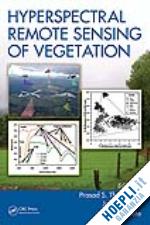Introduction and Overview Advances in Hyperspectral Remote Sensing of Vegetation and Agricultural Croplands, Prasad S. Thenkabail, John G. Lyon, and Alfredo Huete Hyperspectral Sensor Systems Hyperspectral Sensor Characteristics: Airborne, Spaceborne, Hand-Held, and Truck-Mounted; Integration of Hyperspectral Data with LIDARFred Ortenberg Hyperspectral Remote Sensing in Global Change StudiesJiaguo Qi, Yoshio Inoue, and Narumon Wiangwang Data Mining, Algorithms, Indices Hyperspectral Data MiningSreekala G. Bajwa and Subodh S. Kulkarni Hyperspectral Data Processing AlgorithmsAntonio Plaza, Javier Plaza, Gabriel Martín, and Sergio Sánchez Leaf and Plant Biophysical and Biochemical Properties Nondestructive Estimation of Foliar Pigment (Chlorophylls, Carotenoids, and Anthocyanins) Contents: Evaluating a Semianalytical Three-Band ModelAnatoly A. Gitelson Forest Leaf Chlorophyll Study Using Hyperspectral Remote SensingYongqin Zhang Estimating Leaf Nitrogen Concentration (LNC) of Cereal Crops with Hyperspectral DataYan Zhu, Wei Wang, and Xia Yao Characterization on Pastures Using Field and Imaging SpectrometersIzaya Numata Optical Remote Sensing of Vegetation Water ContentColombo Roberto, Busetto Lorenzo, Meroni Michele, Rossini Micol, and Panigada Cinzia Estimation of Nitrogen Content in Crops and Pastures Using Hyperspectral Vegetation IndicesDaniela Stroppiana, F. Fava, M. Boschetti, and P.A. Brivio Vegetation Biophysical Properties Spectral Bioindicators of Photosynthetic Efficiency and Vegetation StressElizabeth M. Middleton, K. Fred Huemmrich, Yen-Ben Cheng, and Hank A. Margolis Spectral and Spatial Methods for Hyperspectral Image Analysis for Estimation of Biophysical and Biochemical Properties of Agricultural CropsVictor Alchanatis and Yafit Cohen Hyperspectral Vegetation IndicesDar A. Roberts, Keely L. Roth, and Ryan L. Perroy Remote Sensing Estimation of Crop Biophysical Characteristics at Various ScalesAnatoly A. Gitelson Vegetation Processes and Function (ET, Water Use, GPP, LUE, Phenology) Hyperspectral Remote Sensing Tools for Quantifying Plant Litter and Invasive Species in Arid EcosystemsPamela Lynn Nagler, B.B. Maruthi Sridhar, Aaryn Dyami Olsson, Willem J.D. van Leeuwen, and Edward P. Glenn Species Identification Crop Type Discrimination Using Hyperspectral DataLênio Soares Galvão, José Carlos Neves Epiphanio, Fábio Marcelo Breunig, and Antônio Roberto Formaggio Identification of Canopy Species in Tropical Forests Using Hyperspectral DataMatthew L. Clark Detecting and Mapping Invasive Plant Species by Using Hyperspectral DataRuiliang Pu Land Cover Applications Hyperspectral Remote Sensing for Forest ManagementValerie Thomas Hyperspectral Remote Sensing of Wetland VegetationElijah Ramsey III and Amina Rangoonwala Characterization of Soil Properties Using Reflectance SpectroscopyE. Ben-Dor Detecting Crop Management, Plant Stress, and Disease Analysis of the Effects of Heavy Metals on Vegetation Hyperspectral Reflectance PropertiesE. Terrence Slonecker Hyperspectral Narrowbands and Their Indices on Assessing Nitrogen Contents of Cotton Crop ApplicationsJianlong Li, Cherry Li, Dehua Zhao, and Chengcheng Gang Using Hyperspectral Data in Precision Farming ApplicationsHaibo Yao, Lie Tang, Lei Tian, Robert L. Brown, Deepak Bhatnagar, and Thomas E. Cleveland Hyperspectral Data in Global Change Studies Hyperspectral Data in Long-Term, Cross-Sensor Continuity StudiesTomoaki Miura and Hiroki Yoshioka Hyperspectral Remote Sensing of Outer Planets Hyperspectral Analysis of Rocky Surfaces on the Earth and Other Planetary BodiesR. Greg Vaughan, Timothy N. Titus, Jeffery R. Johnson, Justin J. Hagerty, Lisa R. Gaddis, Laurence A. Soderblom, and Paul E. Geissler Conclusions and Way Forward Hyperspectral Remote Sensing of Vegetation and Agricultural Crops: Knowledge Gain and Knowledge Gap After 40 Years of ResearchPrasad S. Thenkabail, John G. Lyon, and Alfredo Huete Index











